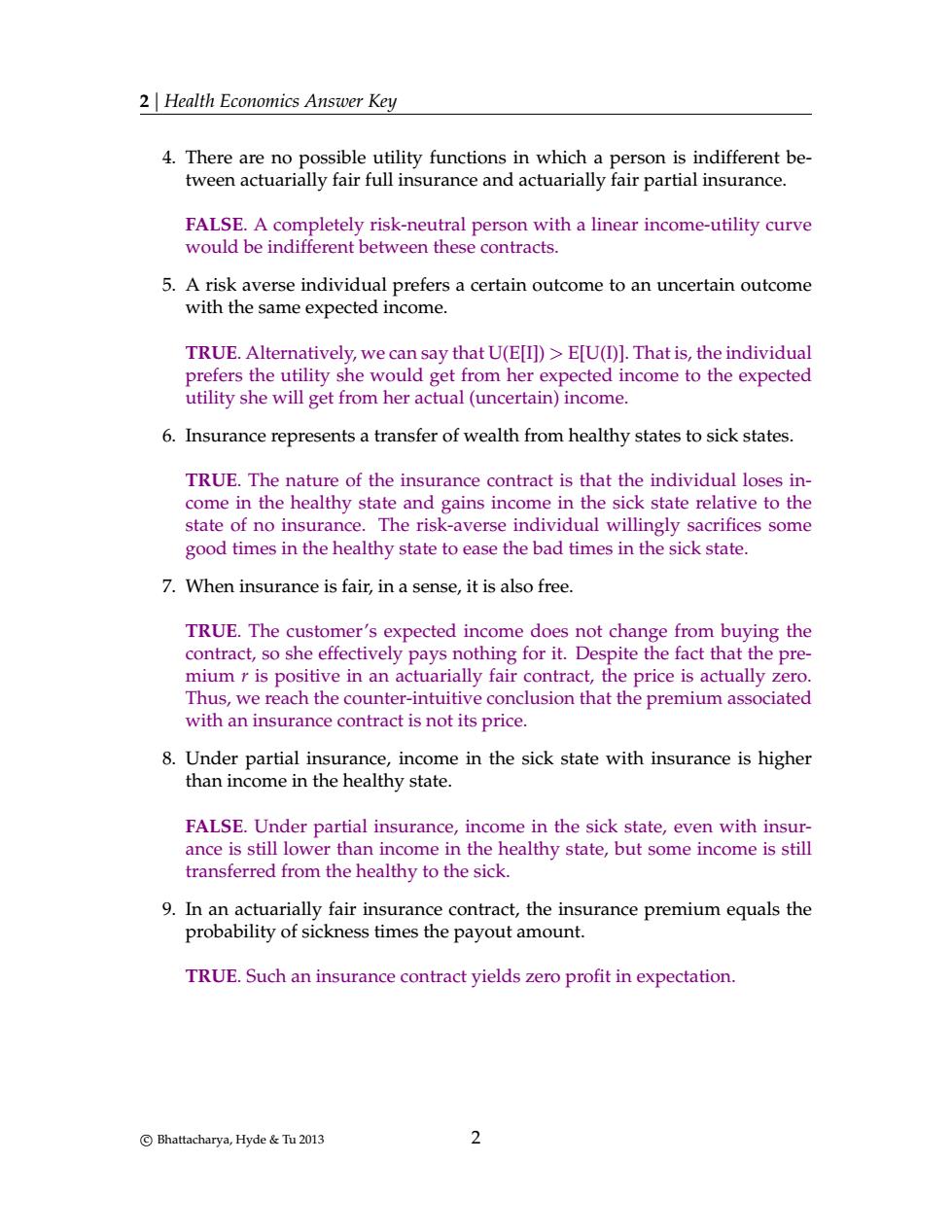正在加载图片...

2 Health Economics Answer Key 4.There are no p possible utility functions in which a person is indifferent be- tween actuarially fair full insurance and actuarially fair partial insurance. FALSE.A completely risk-neutral person with a linear income-utility curve would be indifferent between these contracts. 5.A risk averse individual prefers a certain outcome to an uncertain outcome with the same expected income. TRUE.Alternatively,we can say that U(E[I])>E[U(D)].That is,the individual prefers the utility she would get from her expected income to the expected utility she will get from her actual(uncertain)income. 6.Insurance represents a transfer of wealth from healthy states to sick states. TRUE.The nature of the insurance contract is that the individual loses in- come in the healthy state and gains income in the sick state relative to the state of no insurance.The risk- 7.When insurance is fair,in a sense,it is also free TRUE.The custon contract,so she effectively pays nothi spite the fact tha he pre mium r is positive in an actuarially fair contract,the price is actually zero. Thus,we reach the counter-intuitive conclusion that the premium associated with an insurance contract is not its price. 8.Under partial insurance,income in the sick state with insurance is higher than income in the healthy state. FALSE.Under partial insurance,income in the sick state,even with insur- ance is still lower than income in the healthy state,but some income is still transferred from the healthy to the sick. 9.In an actuarially fair insurance contract,the insurance premium equals the probability of sickness times the payout amount. TRUE.Such an insurance contract yields zero profit in expectation Bhattacharya,Hyde &Tu 20132 | Health Economics Answer Key 4. There are no possible utility functions in which a person is indifferent between actuarially fair full insurance and actuarially fair partial insurance. FALSE. A completely risk-neutral person with a linear income-utility curve would be indifferent between these contracts. 5. A risk averse individual prefers a certain outcome to an uncertain outcome with the same expected income. TRUE. Alternatively, we can say that U(E[I]) > E[U(I)]. That is, the individual prefers the utility she would get from her expected income to the expected utility she will get from her actual (uncertain) income. 6. Insurance represents a transfer of wealth from healthy states to sick states. TRUE. The nature of the insurance contract is that the individual loses income in the healthy state and gains income in the sick state relative to the state of no insurance. The risk-averse individual willingly sacrifices some good times in the healthy state to ease the bad times in the sick state. 7. When insurance is fair, in a sense, it is also free. TRUE. The customer’s expected income does not change from buying the contract, so she effectively pays nothing for it. Despite the fact that the premium r is positive in an actuarially fair contract, the price is actually zero. Thus, we reach the counter-intuitive conclusion that the premium associated with an insurance contract is not its price. 8. Under partial insurance, income in the sick state with insurance is higher than income in the healthy state. FALSE. Under partial insurance, income in the sick state, even with insurance is still lower than income in the healthy state, but some income is still transferred from the healthy to the sick. 9. In an actuarially fair insurance contract, the insurance premium equals the probability of sickness times the payout amount. TRUE. Such an insurance contract yields zero profit in expectation. c Bhattacharya, Hyde & Tu 2013 2